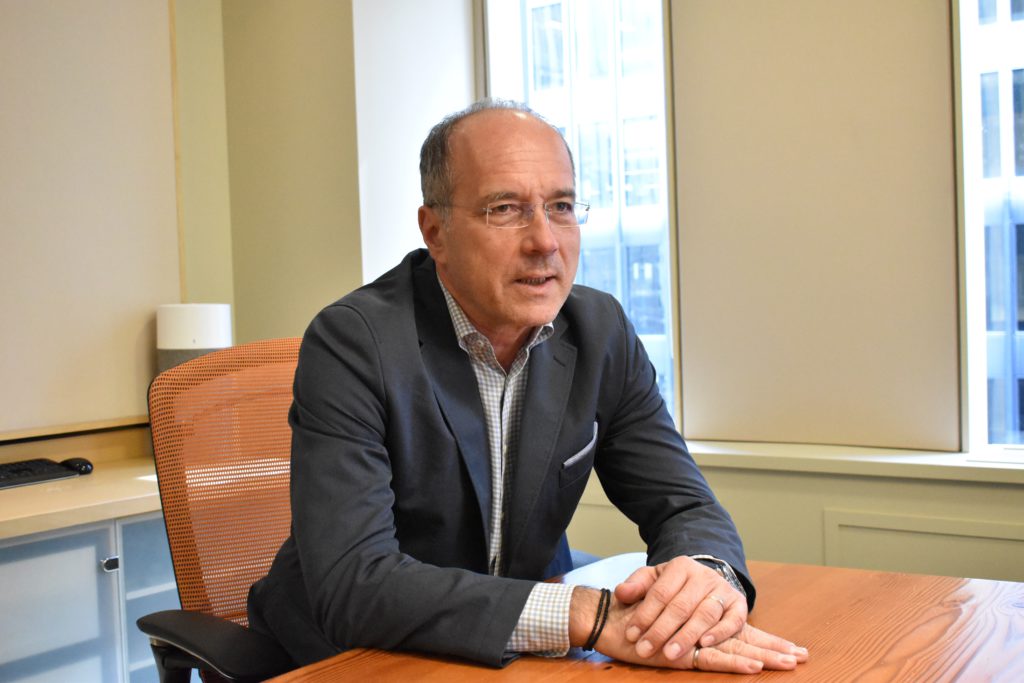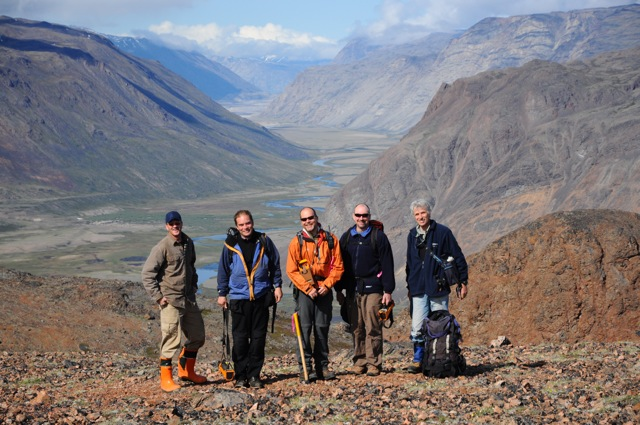Canadian-based permanent magnet manufacturer Neo Performance Materials (TSX: NEO) is preparing for its first exploration program at its Sarfartoq rare earths project in Greenland, just as its CEO and founder Constantine Karayannopoulous announced his retirement.
The $368-million market cap company uses rare earths to make magnetic powders, magnets, specialty chemicals and metals for industrial customers at production facilities in several countries including Canada, Germany, China and Thailand. It also recently became a permanent magnet manufacturer, after acquiring a 90% stake in U.K.-based ST Technologies Group in April.
CEO Constantine Karayannopoulos told The Northern Miner on Thursday about his plans to retire, saying that he had tried to retire three years ago but he negotiated a final tenure of three more years.

“We’re trying to change the way supply chains work,” says Neo Performance Materials CEO Constantine Karayannopoulous. Credit: Blair McBride
“Life is more than just work and I’ve been really working my ass off for the last 30 years in this job, starting this company and changing hands,” he said.
Neo President and Chief Financial Officer Rahim Suleman will take over as CEO after Jul. 7.
The company acquired Sarfartoq last year as a way to minimize the price volatility of permanent magnets for its customers in the automotive industry.
It is now preparing for a summer drilling program at its Sarfartoq rare earths project in Greenland, as it targets a preliminary economic assessment (PEA) for 2024.
On May 3, Neo transferred an exploration licence that was greenlit by the Greenlandic government to its special purpose subsidiary Neo North Star Resources (NNSR), which will do the drilling at Sarfartoq, located near the town of Kangerlussuaq in the southwest.
“We have had a number of discussions with the Greenland government [and] they’ve been very supportive of the project,” Karayannopoulos said. “This was the last remaining box that had to be ticked before the deal closed. We can start working on the site and take it to the next level.”
Neo purchased the licence from Hudson Resources (TSXV: HUD) for US$3.5 million, in a binding agreement announced last August.
“The folks like us that are the value-added producers…have to become miners ourselves. That’s why we set up NNSR,” Karayannopoulos said.
Capping off its latest news, Neo shareholders will in June vote on a rights plan that was floated last September, after the agreement with Hudson was announced.
Australian rare earths developer Hastings Technology Metals (ASX: HAS) said last August it would acquire a 22.1% stake in Neo from an affiliate of Oaktree Capital Management, L.P. Hastings financed its stake using the A$150 million ($135 million) that privately-held Wyloo Metals invested in Hastings. The company aims to start production at its flagship Yangibana project in Western Australia in 2025.
Karayannopoulos said he was surprised at the time to hear from Oaktree that it had sold its majority stake to Hastings.
“They have an interesting project in Australia, which, if they can bring it to market, it would be very useful for them to be a raw material supplier to our Estonian facility,” he said. “We told them, if you build it, we will buy from you, as long as your product meets some specifications. However, we also made it very clear to them that we cannot take the technical risk of delivering that project and we cannot possibly take the financial risk.”
That acquisition prompted Neo’s board of directors to approve a shareholder rights plan about a month later to ensure that all shareholders are treated fairly amid any “unsolicited take-over bids” or acquisitions of control over a significant interest in the company. While the plan was subject to acceptance by the Toronto Stock Exchange and ratification by shareholders within six months of its adoption, in February this year Neo said it was postponing ratification in a combined annual and special meeting of shareholders until June.
The CEO said that since “no troubles had surfaced by March” the postponement came down to logistics and costs.
“Instead of spending $150,000 on mailing costs, and a ton of work between lawyers, management, and consultants to write that circular for the shareholders, might as well do this once because if we had that meeting in March, we would have to incur the expenses, write a circular and then update that circular two months later, before we mailed for June,” he said. “We felt that since there wasn’t an obvious, imminent threat…we decided to take the risk for a couple of months and wait for the annual general meeting. [There was] nothing else that was in play there.”
Summer exploration
Neo’s exploration licence covers part of the larger Sarfartoq carbonatite complex that also hosts Hudson’s ST1 rare earth elements project and the Nukittooq niobium-tantalum project.
Both projects contain neodymium and praseodymium in an indicated resource of 5.9 million tonnes averaging 1.8% total rare earth oxides (TREO), according to a 2012 update to Hudson’s PEA published in 2011. Inferred resources accounted for 2.5 million tonnes averaging 1.6% TREO for the ST1 zone, based on a 1% cut-off grade.
About 3 km east of ST1 is the ST40 high grade zone that hosts a 45% ratio of neodymium oxide to TREO, which Neo calls “one of the rare earth industry’s highest-known ratios.”
For its new PEA, Neo is preparing to start a drilling program at Sarfartoq that will run from June until October, with drill contractors and workers currently heading to a camp at the site, located at the end of a fjord and about 320 km north of the capital of Nuuk.
Up to 7,500 metres of mostly infill drilling is planned for the program and Neo has sufficient financing to complete it and the PEA, though Karayannopoulos said the budget is confidential. The company hopes to complete the PEA by the first quarter of 2024.
While the 2011 PEA focussed on one of 40 prospective sites at Sarfartoq, the new assessment will look to confirm the previous findings and then explore one or two more sites.
“Then next year and the year after we keep drilling and identifying not only the size, perhaps more importantly, we need to identify the quality of the resource,” Karayannopoulos said. “We need to look for more accurate descriptions of mineralogy…because that dictates what your flow sheet looks like, and how expensive it’s going to be to build.”
The Toronto-based company felt the need to do its own PEA after the initial one so it could utilize better technology and so that its technical staff could “bless the work” already done, the CEO explained.
“We think that the combination of the characteristics of the deposit — tonnage, grade, mineralogy — combined with a flow sheet that we have seen rough estimates of. If we can confirm it, I think it could mean that this is a resource that can reasonably easily and at a very competitive cost be brought to market.”
Greening its supply chain
The project in Greenland fits into Neo’s “magnets-to-mine” sustainable supply chain strategy.
The rare earths at Sarfartoq have a low uranium content, which allows Neo to explore for them after the government banned uranium mining in 2021. In addition, the project sits beside a deep water fjord, from where ships can transport rare earth concentrate across the North Atlantic and to Sillamae, Estonia. Neo’s affiliate, NPM Silmet OÜ is building a rare earth separation facility there.
The feedstock will then be transported to a rare earth permanent magnet manufacturing plant that Neo plans to build in Narva, just east of Sillamae.
NNSR has entered into an offtake agreement with NPM Silmet OÜ that gives Silmet rights to buy up to 60% of the ore or mineral concentrate produced from Sarfartoq once it’s operational.
Last November, Neo was awarded a grant of up to €18.7 million ($28.1 million) from the Estonian government under Europe’s Just Transition Fund towards the Narva plant’s construction. It was reportedly the first ever grant given out to a critical minerals company in the European Union.
That facility is to eventually provide European manufacturers with magnets for electric and hybrid vehicles, wind turbines and energy-saving electric motors and pumps.
Neo also has a supply agreement with Energy Fuels (TSX: EFR; NYSE: UUUU), where the Colorado-based producer of uranium, vanadium and rare earths provides Neo with mixed rare earth carbonate produced at its White Mesa Mill in Utah, which was initially mined as monazite sand ore in Georgia by Chemours (NYSE: CC).
Neo shares traded at $8.15 as of mid-day on Wednesday in Toronto, valuing the company at $368.3 million. The shares traded in a 52-week window of $7.17 and $17.20.


Be the first to comment on "Neo Performance Materials preps to drill at Greenland rare earths project as CEO steps down"